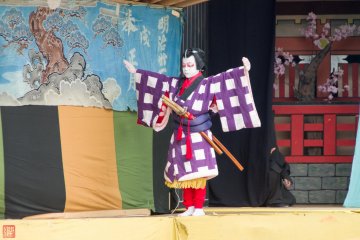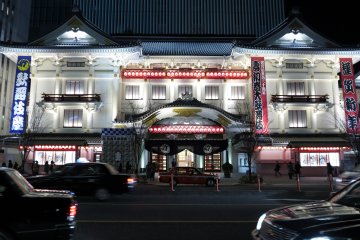What is Kabuki?
Kabuki was born in early 17th-century Kyoto as street theater for the common people. A lively mix of drama, dance, and live music, it was initially performed by women until government bans over moral concerns led to all-male casts. Male actors known as onnagata then took over female roles, dedicating years to perfecting the gestures, voice, and movements that convey femininity — a tradition unique to kabuki and which continues to this day.

Classic kabuki plays fall into three main genres, each showcasing a different facet of the art form:
- Historical dramas (jidaimono) depict the struggles of samurai, nobles, and legendary heroes in feudal Japan, exploring themes of loyalty, betrayal, and political struggle.
- Domestic plays (sewamono) focus on everyday life in Edo-period towns, with storylines that revolve around love, family, and personal struggles.
- Dance performances (shosagoto) rely on music and gesture to convey emotion, ranging from simpler non-narrative pieces to performances with complex storylines.

In recent years, kabuki has undergone significant innovation to stay relevant in modern Japan. These contemporary works, known as shinsaku kabuki, frequently draw from popular anime, manga, and television dramas to create bold new productions specifically designed to attract younger audiences while honoring traditional theatrical techniques.

Why Kabukiza?
For those seeking an authentic kabuki experience in Tokyo, Kabukiza stands as the art form's most prestigious venue. Situated in Ginza's luxury shopping district, Kabukiza has served as the headquarters of Shochiku, Japan's oldest entertainment company, since 1889. As one of Tokyo's largest traditional theaters, Kabukiza's four-tiered auditorium accommodates nearly 1,800 people without losing the intimacy essential to kabuki performance.

The adjacent tower also houses the Kabukiza Gallery, which showcases costumes, stage props, and makeup designs from actual kabuki productions. These displays reveal the intricate craftsmanship required for each performance, making it a worthwhile visit for anyone curious about Japanese theatrical traditions.
Ticket Options
Kabukiza hosts performances every day, with sessions in the late morning, afternoon, and evening. Each block lasts several hours and usually includes three acts, drawn from plays of different genres. The program changes monthly, so even regular visitors will encounter something new.
Tickets can be purchased online through Shochiku’s official website, by phone, or at the theater box office. Visitors can choose between three types of tickets:
- Regular tickets cover one full block of performances, suitable for those seeking the full traditional experience.
- Prices range from about ¥4,500 to ¥20,000, depending on seat class and location.
- Phone and online reservations close the day before the performance.
- Remaining tickets can usually be purchased at the theater box office on the day.
- Single-act tickets allow you to watch just one act, perfect for newcomers or those short on time. These are limited to 4th-level seating.
- Prices range from about ¥800 to ¥2,800, depending on the act's duration.
- Online reservations open at noon the day before the show with seat selection.
- Same-day tickets are also sold at the box office from 10 a.m. but seats cannot be chosen.
- Upgraded single-act tickets, available exclusively to foreign visitors, offer the best of both worlds. These provide 2nd-floor seating with a better view of the stage.
- Prices range from about ¥3,000 to ¥10,000, depending on the act's duration.
- Online reservations open at noon the day before the show and close at 5 p.m. on the day of the show. These tickets cannot be purchased at the box office.
- After the 5 p.m. deadline, only standard single-act tickets are available.
Language and Accessibility
While performances are conducted entirely in Japanese, English-speaking visitors have several options to follow along. Handheld captioning devices that provide real-time English translations of dialogue, lyrics, and cultural explanations are available for rent. You can find these on the day of the performance near the box office. Payment is cash only:
- Full show (seats on 1st to 3rd levels): ¥1,500
- Single act (seats on 2nd or 4th levels): ¥1,000
Additionally, free English flyers are provided. Visitors can also purchase Japanese-language program booklets which include detailed English synopses at the end.
Missed a Show?
For those who can’t make it to Kabukiza in person, performances are also available online through Shochiku’s Kabuki on Demand service. This platform offers access to recorded performances with English subtitles, allowing viewers worldwide to experience kabuki from home.










